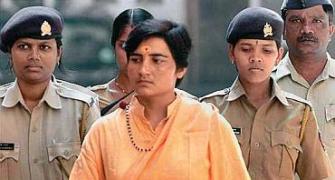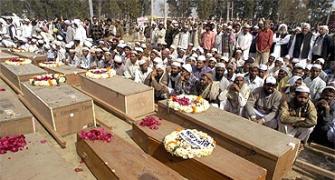On Monday, as seven of the nine accused who were granted bail in the 2006 Malegaon blasts are set to be released from jail, there was a sense of relief in Nashik town. For years, investigators have been suspecting the involvement of Muslim youths in this case.
It's just a matter of time that the National Investigating Agency files its status report in the case, which is likely to indict the two accused -- Sadhvi Pragya Singh Thakur and Lieutenant Colonel Srikant Purohit.
The focus of the probe in the 2006 Malegaon blasts case has been on the confessions made by Swami Aseemanand, a key figure in the Hindutva terror network. After having admitted to have planned terror attacks on Ajmer Sharif, Mecca Masjid, Malegaon and the Samjhauta Express, Aseemanand retracted his statement. But it was this confession that made it easier of the NIA to gather leads in the 2006 case.
Aseemanand's retraction will not have much impact on the case, according to legal experts. He will have to prove before the trial court that the statement was made under duress. And if he does prove this the court will have to direct the magistrate before whom the statement was made to testify. But despite this the NIA will tread carefully and only use the confession to obtain leads rather than document it before the court.
Today, the investigators are close to cracking the case. But for years the biggest point of debate has been over who planted the bombs in the Muslim cemetery. Hemant Karkare, who led the investigations in the 2008 Malegaon blasts, gave a new dimension to the case after he pointed out the involvement of some radical Hindu groups in terror-related activities. One of angles that was being probed was that Purohit threatened some Muslim youths from the banned Students Islamic Movement of India to prepare the bombs since they had the required expertise. Another theory was that Muslim youths were hired by Hindu extremists to plant the bombs.
Investigations into the 2006 Nanded blast, which investigators say was one of the first terror activities involving Hindu extremists, point out to yet another interesting tactic deployed by saffron extremists.
During a raid that was conducted after the Nanded blast, the police recovered Muslim attire, skullcaps and fake beards at a place where the operation was allegedly planned. During the course of the investigation it was also found that Hindu radicals planned to dress up like Muslims to plant bombs in a move to malign the minority community.
Investigators say that those behind the 2006 Malegaon blasts could have also disguised themselves as Muslims. Soon after the blasts a Muslim newspaper The Milli Gazette reported that a corpse with a fake beard was discovered while lifting bodies after the strike. The police in Malegaon immediately took charge of the body and claimed to have sent it to Nashik. However, the next day it denied that any such body was ever found, said the report.
The report also said that the news of the corpse with the fake beard was carried by Delhi's Urdu daily Hindustan Express on September 9, 2006 and the Mumbai-based Inquilab on September 11, 2006.
Probe agencies have been able to draw a lot of similarities between the attacks in Nanded and Malegaon operations. However, investigators have not been able to reach at a conclusive decision regarding the hiring of Muslim youth to plant bombs or Hindu extremists disguising themselves.
But, Aseemanand had admitted to investigators that he had developed a deep sense of vengeance against Muslims in general. One of the accused in the Nanded blasts -- Manohar Rao -- had confessed to having procured Muslim attire, beards and caps. The accused have said that they wanted to mislead the police by leaving traces of the involvement of the Muslim community. If they planted bombs disguised as Muslims the eyewitnesses' account would reveal the same.
The module also created fake email ids in the names of Muslims once again with an intention of misguiding investigators. A similar modus operandi was used in the terror operations carried out in the Marathwada region in central Maharashtra -- at Jalna, Purna and Parbhani, say insiders.
Aseemanand in his confessions made no mention of the Nanded, Parbhani, Jalna and Purna operations and only spoke about the Mecca Masjid, Malegaon, Samjautha and Ajmer blasts. This clearly indicates that two different modules were involved in the attacks though their motives were similar.
The accused in the Nanded case said that they wanted to hit back at the Dawood Ibhraim gang for helping terrorists carry out 2003 Mumbai twin blasts at Gateway of India and Zaveri Bazaar. Aseemanand also speaks about similar revenge when he propounded the "bomb ka badla bomb" theory.
The NIA is expected to file a status report in the 2006 Malegaon case, but that's going to be no cakewalk. "Like the Mecca Masjid case, while probing the Malegaon we were misled and a lot needs to be undone. Moreover, the four cases -- Mecca Masjid, Malegaon, Samjautha and Ajmer blats -- are interlinked," say NIA officials.









